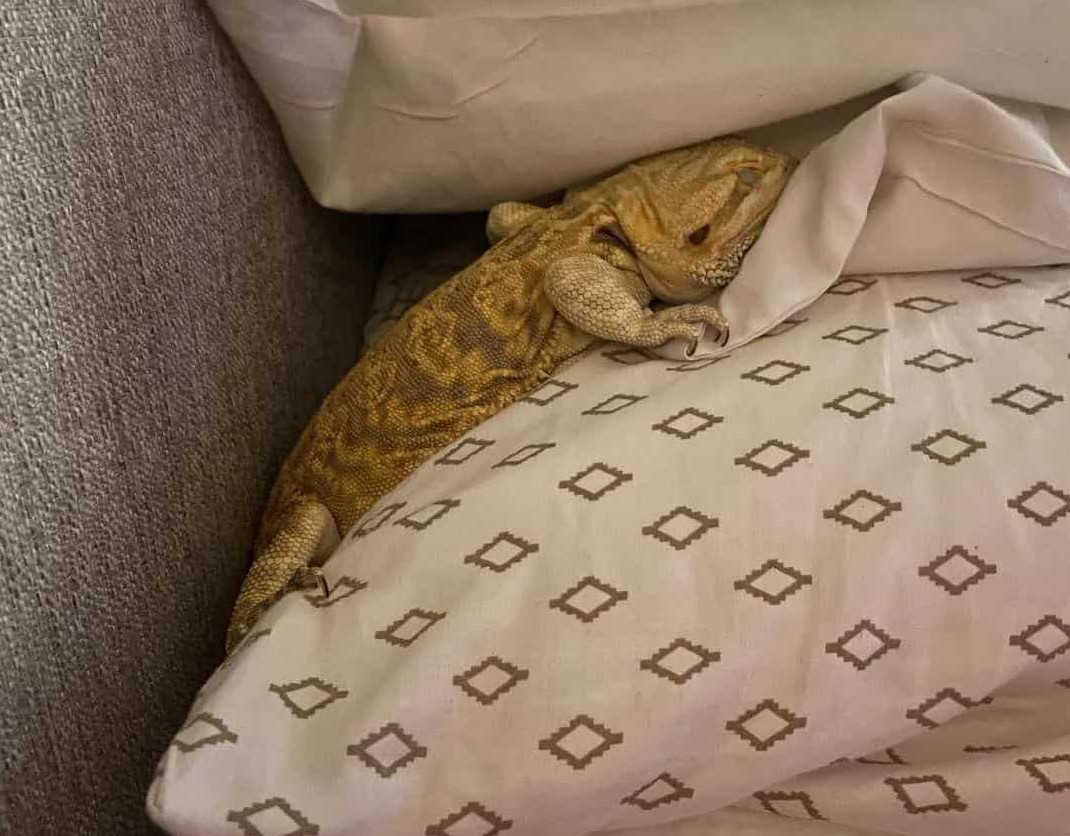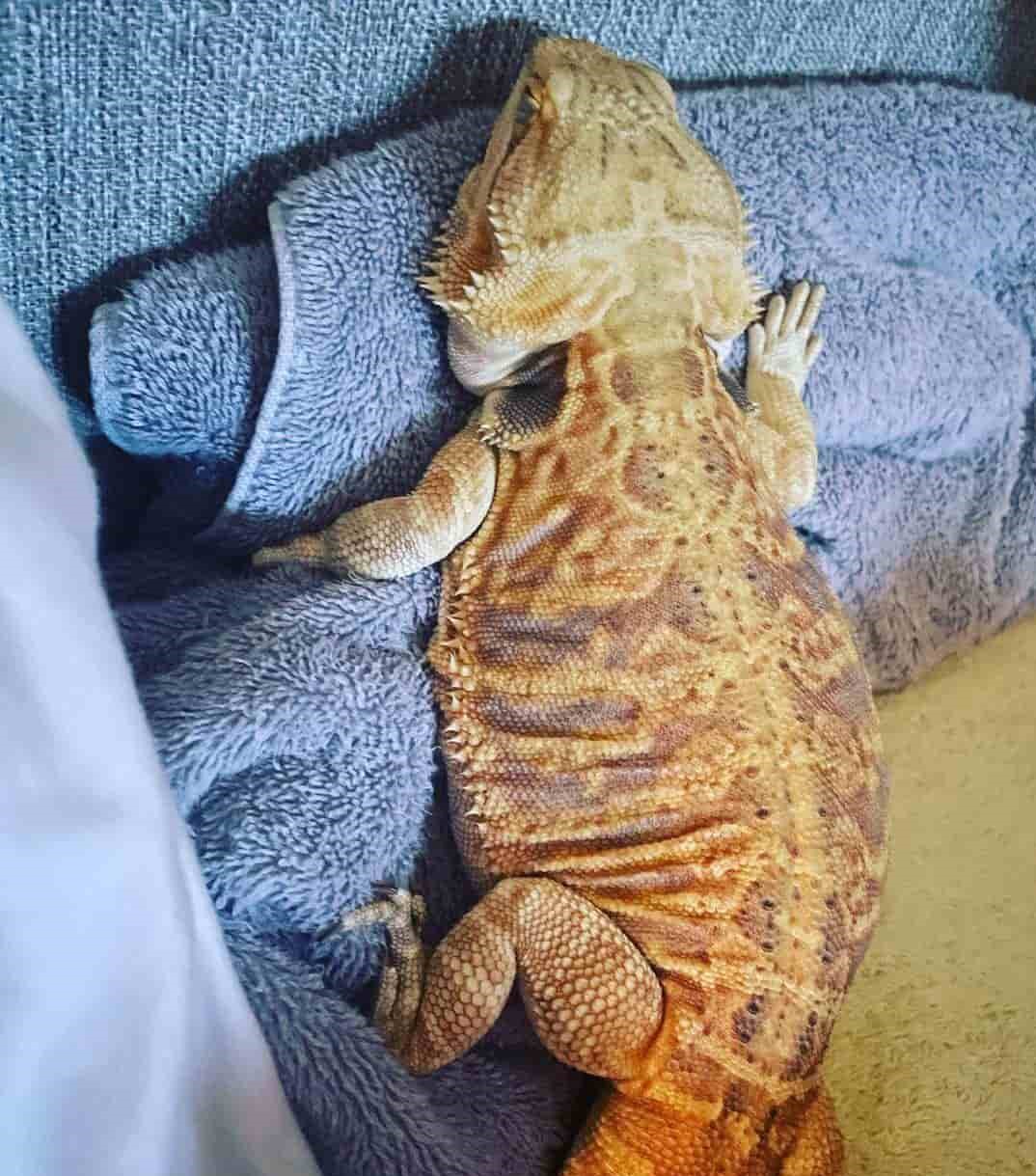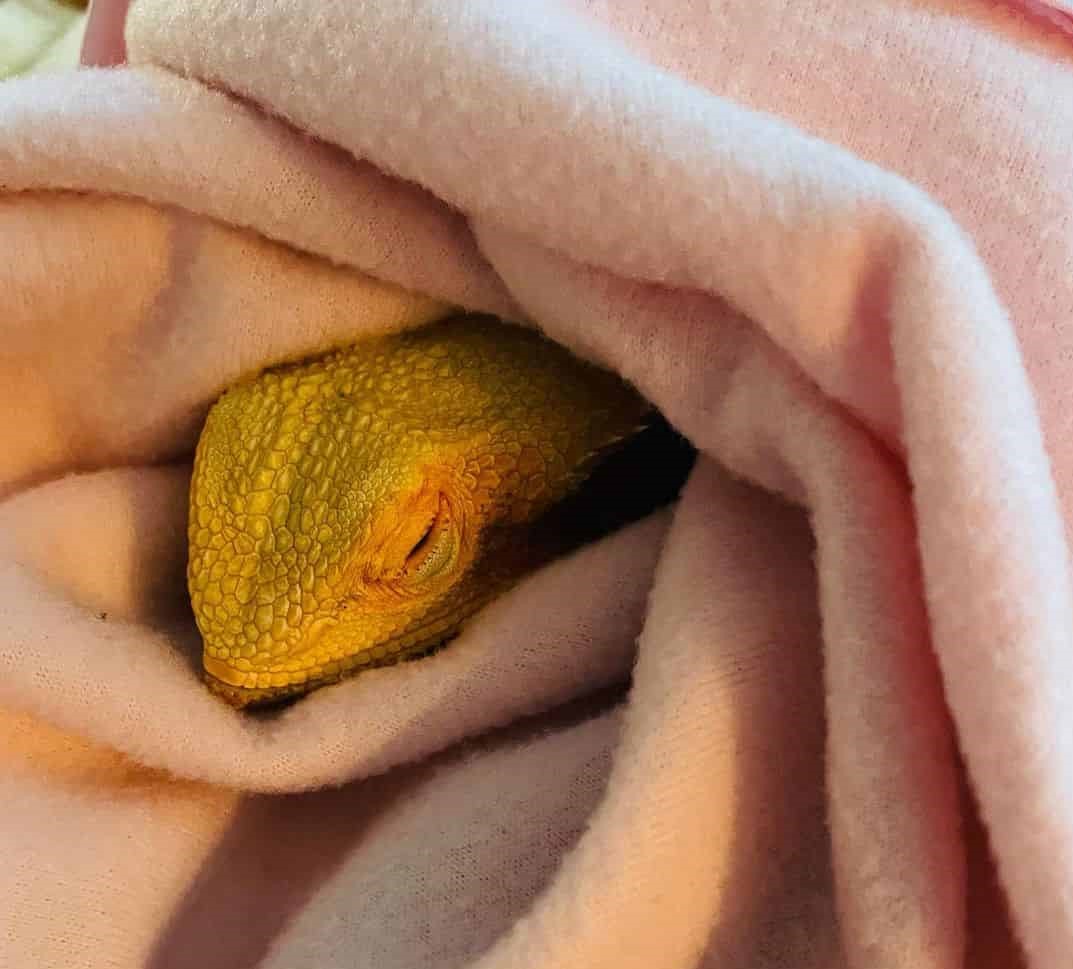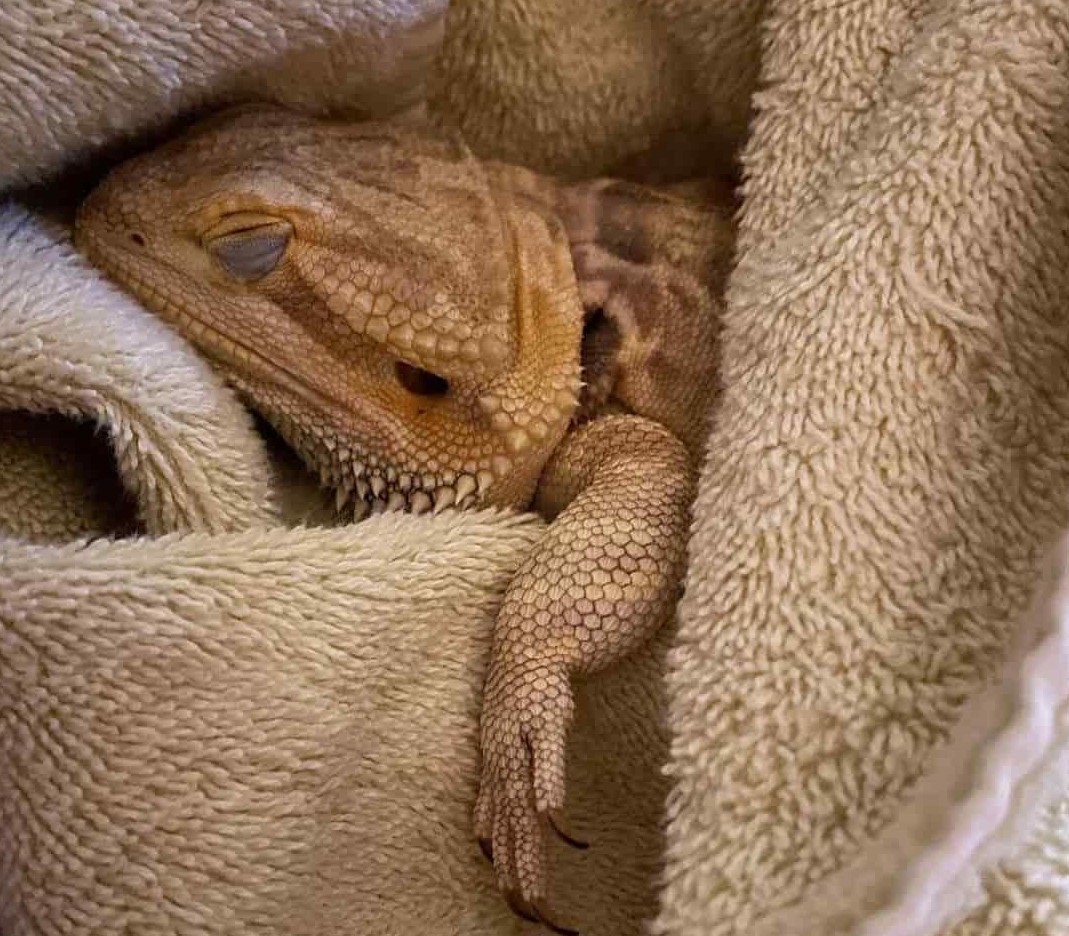Have you ever glimpsed your scaly companion in a state of deep sleep, as if caught in a fairytale slumber?
Your bearded dragon may be in “brumation” – the reptilian equivalent of hibernation.
Brumation is a spellbinding period of dormancy that bearded dragons undergo.
It’s a time when their usual lively antics give way to a serene stillness, leaving pet owners perplexed yet curious.
In this article, we embark on an expedition into the heart of bearded dragon brumation, where we’ll unlock its purpose, duration, and the essential care needed during brumation to ensure a safe journey for your scaly companion.
So grab a cup of coffee and let’s dive in!
Table of Contents
What is Brumation in Bearded Dragons?

Before we dive into the fascinating world of bearded dragon brumation, let’s uncover the essence of this peculiar phenomenon. Brumation is a naturally occurring state of dormancy observed in certain reptiles, including our scaly companions.
It’s a period of reduced activity and altered behavior that occurs in response to seasonal changes. But don’t be fooled by their apparent slumber! Brumation is a vital part of a bearded dragon’s life cycle, allowing them to conserve energy, rejuvenate, and prepare for the next chapter of their scaly adventures.
How Long Does Brumation Last?
The duration of brumation can vary among bearded dragons, ranging from a few weeks to several months. It typically lasts anywhere between 4 to 10 weeks, although some dragons may extend their brumation period up to 3 or 4 months.
The duration depends on various factors, including the dragon’s age, health, environmental conditions, and individual differences. It’s crucial to monitor your dragon closely during this time and provide appropriate care to ensure a safe and healthy brumation experience.
When Do Bearded Dragons Enter Brumation?
Bearded dragons usually enter brumation during the winter months when temperatures drop and daylight hours shorten. However, the exact timing can vary depending on the specific geographic location and individual dragon’s biological clock.
Generally, adult bearded dragons tend to brumate more frequently than juveniles. It’s important to note that not all bearded dragons will undergo brumation, and some may exhibit a reduced activity level without entering a true brumation state.
Pay attention to your dragon’s behavior and consult a reptile veterinarian if you have any concerns.
Differences between Brumation and Hibernation
Although brumation and hibernation share similarities, they are distinct in their processes and purposes. Brumation is a term used for reptiles’ dormant state, while hibernation refers specifically to the dormancy of mammals.
One key difference is that reptiles in brumation maintain a higher metabolic rate compared to mammals in hibernation. Additionally, brumating reptiles may occasionally wake up to drink water or adjust their position, whereas hibernating mammals experience prolonged periods of deep sleep.
Understanding these differences helps us appreciate the unique adaptations of our scaly friends during their winter slumber.
Signs that Your Bearded Dragon Is Brumating

As bearded dragons enter the period of brumation, it’s important to recognize the signs of their dormant state for their well-being. Understanding the physical and behavioral indicators can help you provide the necessary care.
Let’s explore the signs that suggest your scaly companion is embracing the slumber of brumation.
Physical Signs
During brumation, bearded dragons may exhibit various physical signs that indicate their dormant state. Sunken eyes are commonly observed as a result of reduced fluid intake and the body’s conservation of resources.
Weight loss is a natural consequence of decreased activity and appetite during brumation, as their metabolic rate slows down. Additionally, brumating dragons often display a lower body temperature as their metabolism slows down to conserve energy.
Sunken eyes
Their eyes may appear slightly sunken due to reduced fluid intake and the body’s conservation of resources during brumation. This is a natural adaptation to their dormant state.
Weight loss
A gradual weight loss is common in brumating dragons due to decreased activity and appetite during this period. However, it’s important to monitor their weight to ensure it doesn’t become excessive.
Reduced body temperature
Brumating dragons often exhibit a lower body temperature as their metabolism slows down to conserve energy and resources. This is a normal physiological response during brumation.
Behavioral Signs
In addition to physical changes, bearded dragons may display behavioral signs indicating brumation. Decreased activity levels are commonly observed as they conserve energy and minimize movements. Reduced appetite or refusal to eat is also common, as their digestive system slows down during brumation.
Furthermore, their sleep patterns may become disrupted, with longer periods of slumber or altered sleep-wake cycles.
Decreased activity levels
Brumating dragons exhibit a significant decrease in their usual activity levels, conserving energy and minimizing movements during this dormant period. They may spend more time resting or sleeping.
Reduced appetite or refusal to eat:
During brumation, bearded dragons often show diminished interest in food or even refuse to eat as their digestive system slows down. This is normal behavior and is temporary during the brumation period.
Altered sleeping patterns
Their sleep patterns may become disrupted, with longer periods of slumber or altered sleep-wake cycles. It’s common for brumating dragons to sleep more than usual.
Burrowing or hiding behavior
During brumation, bearded dragons may tend to burrow or hide away in secluded spots within their enclosure. This behavior serves as an instinct to find a safe and cozy retreat during their dormant period.
Lack of interest in surroundings or decreased responsiveness
Brumating dragons often show a lack of interest in their surroundings and may exhibit decreased responsiveness to stimuli. This reduced engagement is a normal part of their dormant state as they conserve energy and focus inward.
Spending more time in cooler areas
Bearded dragons undergoing brumation tend to prefer spending more time in cooler areas of their enclosure. They seek out these spots to create an environment that mimics the natural temperature fluctuations they would experience in the wild.
Slowed or shallow breathing
As their metabolic rate slows down during brumation, bearded dragons may exhibit slowed or shallow breathing. This reduced respiratory activity is a normal physiological adaptation to conserve energy and resources.
Preparing for Brumation
Preparing your bearded dragon for brumation ensures a smooth transition into this dormant phase. Here are a few important steps to take:
- Gradual temperature reduction: Start by gradually reducing the temperature in their enclosure. Lower the basking spot temperature and nighttime temperatures slightly to mimic the natural cooling patterns they would experience in the wild.
- Lighting adjustments: Adjust the lighting to provide a shorter photoperiod. Decrease the hours of light exposure to simulate the changing daylight hours during winter.
- Monitoring food intake: As your bearded dragon prepares for brumation, their appetite will naturally decrease. Ensure they receive a nutritious meal before brumation begins and continue to offer food but be mindful that they may eat less or refuse food during this time.
- Hydration: Provide access to a shallow water dish throughout the brumation, even though their water intake will decrease. It’s important to keep them hydrated, but avoid misting or bathing during this period.
Signs of Dead Bearded Dragon
While brumation is a natural process, it’s important to be able to differentiate the potential signs of brumation or dead bearded dragon. Here are some indications that may suggest your bearded dragon has passed away:
- Lack of response: A dead bearded dragon will show no response to stimuli. They won’t move, blink, or show any signs of life when touched or approached.
- Stiff or rigid body: The body of a deceased bearded dragon will feel stiff and rigid to the touch. Rigor mortis sets in shortly after death and makes their limbs and body immovable.
- Foul odor: A strong, unpleasant odor is often associated with decomposition. If you notice a foul smell coming from your bearded dragon’s enclosure, it may indicate that they have passed away.
- Signs of decay: Physical signs of decay, such as discoloration, bloating, or visible decomposition, are clear indicators that your bearded dragon has died.
Addressing Concerns: Is My Bearded Dragon Dead or Brumating?
Distinguishing between a deceased bearded dragon and one in brumation can be challenging. If you’re unsure, consider the following steps to help you address your concerns:
- Check for signs of life: Gently observe your bearded dragon for any signs of movement, breathing, or response to touch. Look for subtle eye or body movements that may indicate they are still alive.
- Observe body temperature: A brumating bearded dragon will have a lower body temperature, but it should still feel slightly warm to the touch. If their body feels cold and shows no signs of life, it may be a cause for concern.
- Seek professional assistance: If you’re uncertain about the status of your bearded dragon, it’s best to consult with a reptile veterinarian. They can perform a thorough examination and provide expert guidance based on their experience and knowledge.
- Consider context and history: Assess the overall health and behavior of your bearded dragon leading up to its current state. If they have been displaying typical brumation signs and have a history of healthy brumation cycles, it’s more likely they are in brumation rather than decreased.
Considering these steps will help you make informed decisions regarding a potential brumation or dead bearded dragon.
How to Care for Your Bearded Dragon During Brumation?

Proper care for your bearded dragon during brumation is crucial to ensure its well-being and support a smooth transition through this dormant phase. While their activity levels and appetite decrease, certain aspects of their care still require attention.
Let’s explore how to provide the best care for your bearded dragon during brumation.
Monitoring Behavior
Keep a close eye on your bearded dragon’s behavior during brumation. While they may be less active, monitor for any concerning changes in behavior, such as prolonged periods of lethargy or signs of distress.
This will help you ensure their well-being and promptly address any potential issues.
Adequate Housing Setup
Maintain an appropriate housing setup for your bearded dragon during brumation. Ensure they have a spacious enclosure with an appropriate substrate for burrowing.
Provide hiding spots and branches for climbing, creating a comfortable and secure environment that mimics their natural habitat.
Proper Lighting and Temperature
Although bearded dragons experience a decrease in their activity levels during brumation, it’s important to maintain proper lighting and temperature. Provide a heat source to create a warm basking spot, as well as a cooler area within their enclosure.
Adjust the lighting schedule to reflect natural daylight fluctuations, maintaining a consistent photoperiod.
Hydration
While bearded dragons’ water intake naturally decreases during brumation, it’s still essential to ensure they remain adequately hydrated. Offer a shallow water dish in their enclosure, monitoring it regularly and refreshing the water when needed.
Additionally, consider occasional gentle misting to provide some moisture.
Nutrition
Adjust the feeding routine of your bearded dragon during brumation. Offer occasional small meals, focusing on easily digestible and nutritious options. Avoid feeding fatty or hard-to-digest foods, as their digestive system slows down.
Monitor their weight and overall condition to ensure they maintain a healthy body condition.
Preventing Stress
Minimize stressors in your bearded dragon’s environment during brumation. Avoid excessive handling or disturbing their sleep. Maintain a calm and quiet atmosphere around their enclosure. Limit any changes to their habitat or routines that could disrupt their brumation period.
What Occurs Once Your Bearded Dragon Awakens?
After the brumation period, your bearded dragon will gradually awaken and resume normal activity. Here’s what you can expect during this transitional phase:
- Increased activity levels: As your bearded dragon emerges from brumation, you’ll notice a gradual increase in its activity levels. They will become more alert, explore their enclosure, and exhibit their usual behaviors.
- Restored appetite: Once awake, your bearded dragon’s appetite will return. Offer them small, nutritious meals and monitor their eating habits to ensure they regain their regular appetite and maintain a healthy diet.
- Reestablishing routines: As they become more active, your bearded dragon will likely reestablish their daily routines. This includes basking under the heat lamp, exploring their surroundings, and engaging with their enrichment items.
- Regained interest in surroundings: After awakening from brumation, your bearded dragon will show renewed interest in their environment. They may exhibit curiosity, investigate new items, and interact with their human caregivers.
When to Seek Veterinary Care?
While brumation is a natural process, there are instances when veterinary care may be necessary.
Here are some situations that warrant seeking veterinary assistance:
- Abnormal behavior: If your bearded dragon displays unusual behavior patterns, such as extreme lethargy, difficulty moving, or persistent disinterest in their surroundings, it’s important to consult a reptile veterinarian for evaluation.
- Significant weight loss or poor appetite: While a slight decrease in appetite is expected during brumation, significant weight loss or a prolonged lack of appetite could indicate underlying health issues. A veterinarian can assess their condition and provide guidance.
- Respiratory issues: If you notice wheezing, labored breathing, or any signs of respiratory distress in your bearded dragon, it’s crucial to seek veterinary care promptly. Respiratory infections can occur during or after brumation and require medical attention.
- Persistent abnormalities: If your bearded dragon shows persistent abnormalities even after fully awakening from brumation, such as abnormal stools, unexplained weakness, or skin abnormalities, it’s advisable to have them examined by a reptile veterinarian.
Remember, your veterinarian is the best resource for assessing your bearded dragon’s health and providing appropriate care. Regular check-ups and open communication with your veterinarian will help ensure your bearded dragon’s well-being.
Conclusion
In conclusion, supporting your bearded dragon during brumation is crucial. Provide a suitable habitat, monitor behavior, and offer proper care for hydration, nutrition, and temperature. Your attentiveness ensures a smooth brumation experience.
This guide offers insights into bearded dragon brumation. Each dragon is unique, so attend to their needs and consult a reptile veterinarian when necessary. Your dedication fosters a strong bond with your dragon.
Thank you for joining us on this exploration of bearded dragon brumation. Embrace their natural cycle, cherish moments of stillness and rejuvenation, and celebrate your dragon’s thriving. Happy brumation and a growing bond with your dragon!
FAQs
How long does brumation typically last for bearded dragons?
Brumation can vary in duration, but it typically lasts anywhere from a few weeks to a few months, depending on the individual bearded dragon and environmental factors.
Is brumation a cause for concern?
Brumation is a natural behavior in bearded dragons and is not usually a cause for concern. However, it’s important to monitor their health and behavior during this period to ensure they remain in good condition.
Can I wake up my bearded dragon from brumation?
It’s generally recommended to let your bearded dragon naturally awaken from brumation. Attempting to wake them up prematurely can be stressful and disrupt their natural cycle. However, if you have concerns about their health, consult a reptile veterinarian for guidance.
Is my bearded dragon dead or hibernating?
If your bearded dragon is unresponsive, not breathing, and shows no movement, it might be passed away. If it’s lethargic, buried, and breathing slowly, it could be hibernating.
Alina Hartley is a small-town girl with a ginormous love of bearded dragons. It all started with Winchester, a baby bearded who was abandoned at the shelter by his former owners because of a birth defect that caused one front leg to be shorter than the other. Alina originally went to the shelter looking for a guinea pig, but one look at Winchester and it was love at first sight. From that day on, Alina has dedicated her life to learning everything she can about bearded dragons. She loves helping new beardie parents start their incredible journey with these magnificent reptiles.
Follow her on:
LINKEDIN
TWITTER.
Read her latest articles HERE
Learn more about her HERE.

